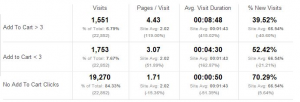 TechKeys, sells custom keys, artisan keys, keyboards and other items for keyboard enthusiasts. The site is an ecommerce store that connects to an offsite gateway where users can purchase items. Because of the offsite connection, there is a discontinuity in data in Google Analytics once users go offsite to purchase items.
TechKeys, sells custom keys, artisan keys, keyboards and other items for keyboard enthusiasts. The site is an ecommerce store that connects to an offsite gateway where users can purchase items. Because of the offsite connection, there is a discontinuity in data in Google Analytics once users go offsite to purchase items.
Transaction Discontinuity Solution
The first data challenge we resolved is collecting goal data in Google Analytics on the amount of purchases that were happening on the website. This allowed us to see how close Google Analytics was to actual purchases that were in the clients payment gateway. Over time we worked to get this data to 97%-99% accuracy. Everyone should keep in mind that Google Analytics is a trending tool, and will not exactly match your actual purchases for various reasons.
Add To Cart Solution
Tracking Add To Carts was our next step. It is an important step in the conversion funnel to understand whom is adding items to their shopping cart. What is the source of traffic that is adding items to their shopping cart. How many items visitors add to their shopping cart.
Google Analytics Add to Cart Optimization
After looking at the data, we noticed that most of the users that purchased on the website added more than 3.5 items to their cart. Because you cannot have half an item as a cart addition we decided to lower it to three. From this knowledge, we created 3 groups of website visitors for TechKeys:
- No items added to Cart
- <3 items added to Cart
- Add to Cart > 3
Insights: Segmented Optimization
TechKeys now has the ability to use these segments as a way to optimize for conversion. Visitors whom add more than 3 items to their cart are likely to purchase. Visitors whom add less than 3 items to their cart need more incentive. Visitors whom add no items to their cart, are not going to purchase. The two segments that have a higher likelihood of purchase can be used as a model to improve the conversion over time.
Related posts: Google Analytics 201, Web Analytics Fundamentals for Quality Insights, Measuring KPIs
